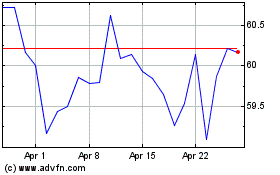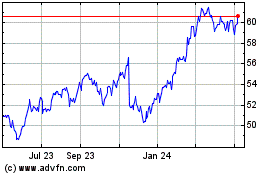By Sarah Nassauer
Wal-Mart Stores Inc. wants to charge more to buy some products
online than in stores, part of the company's efforts to boost
profits and drive store traffic as it competes with Amazon.com
Inc.
The world's biggest retailer has quietly raised prices for some
food and household items sold on its U.S. website, including boxes
of Kraft Macaroni & Cheese, Colgate toothbrushes and bags of
Purina dog food, according to people familiar with the matter and
comparisons between online and in-store prices.
Some big-box retailers charge more for online purchases,
including Costco Wholesale Corp., but the move is unusual for
Wal-Mart, which has long honed an "everyday low price" message and
has worked to keep online prices at least as low as shoppers find
in its 4,700 U.S. stores.
Wal-Mart previously aimed to keep online and in-store prices
equal for many of its most popular products -- unless competition
drove them lower. But the company is experimenting with a new
system, which has at times resulted in higher web prices for goods
that would otherwise be unprofitable to ship, the people familiar
with the situation said.
In some cases, product listings on walmart.com show an "online"
and "in the store" price. Often the online price matches
Amazon.
"We always work to offer the best price online relative to other
sites," a Wal-Mart spokeswoman said. "It simply costs less to sell
some items in stores. Customers can access those store prices
online when they choose to pick up the item in store."
On Friday, a box of Kraft Thick n' Creamy Macaroni & Cheese
Dinner was $1.48 on walmart.com, the same as Amazon's price but
more than Wal-Mart's $1.28 store price (listed online). A similar
comparison for a twin-pack of Betty Crocker Hamburger Helper showed
the price as $3.30 online, but $2.50 if purchased at a Wal-Mart
store in Illinois.
The higher online prices are part of Wal-Mart's efforts to nudge
more customers into stores as well as raise its e-commerce margins
by offsetting the cost to ship orders to homes.
A $1.28 box of Kraft Macaroni & Cheese could cost a big
retailer around $10 to ship from Chicago to Atlanta, depending on
how remote the buyer's address is, according to a cost analysis by
consultants Spend Management Experts. A smaller retailer would
likely pay about double. A twin pack of Hamburger Helper could cost
around $10 to ship between Minneapolis and Atlanta, estimates the
firm.
Wal-Mart is investing billions to boost e-commerce sales, which
rose 60% in the U.S. in the most recent quarter, but some
shareholders worry the effort could drag on profits.
Marc Lore, head of Wal-Mart's U.S. e-commerce unit, told
investors in October that "this year should be the largest loss in
e-commerce, and we'll see slight improvement next year."
Overall, Wal-Mart expects profit margins to be slightly down
this year. Wal-Mart's net income has declined the past two fiscal
years, down 7.2% to $13.6 billion last fiscal year ended Jan. 31,
2017. The company is scheduled to report third-quarter earnings on
Thursday.
Since Wal-Mart's current chief executive Doug McMillon took the
job in 2014, the retailer shifted its growth strategy from building
more cavernous supercenters to improving existing stores and
investing in e-commerce. In 2015 it closed more than 150 U.S.
stores, and it plans to build just two dozen stores next fiscal
year.
Without new stores, Wal-Mart executives say they will grow sales
by bring more shoppers to existing locations and driving online
sales. Wal-Mart has raised starting wages for store employees,
refurbished stores and bought smaller online retailer startups.
So far, the bet is working. Wal-Mart has grown sales in existing
stores for 12 consecutive quarters, boosted by more shoppers coming
to stores at a time when many traditional retailers face sluggish
sales. Its stock closed at an all time high Friday at $90.92.
But Amazon continues to grab market share. Amazon is expected to
earn 43.5% of U.S. online sales this year, up from 38.1% last year,
according to eMarketer, a research firm. Wal-Mart will grow to
3.6%, from 2.8% last year, said the firm.
Wal-Mart e-commerce workers responsible for product sales have
been instructed to boost profits along with sales, according to the
people familiar with the situation, and are "no longer obligated to
follow store pricing," one of them said.
The company is also asking suppliers to sell more of their
merchandise in bulk versions -- instead of single boxes -- to
increase order sizes and make them more profitable, the people
said.
For inexpensive items, "there's no cheaper way to get these
products to consumers than have them come in the store and pick it
off the shelf themselves," Mr. Lore said at last month's investor
conference. He said he hopes shoppers will come to stores for the
best price and place larger orders online to offset the cost of
shipment.
After scrapping an effort earlier this year to create a
membership delivery program to rival Amazon Prime, Wal-Mart offers
free two-day shipping on millions of items on any order above
$35.
Mr. Lore founded online retailer Jet.com Inc., which Wal-Mart
bought last year for $3.3 billion. Since he became head of
Wal-Mart's U.S. e-commerce division, the company has become more
experimental with online marketing and pricing, including offering
more discount codes and working with companies that publicize
discounts through mobile applications.
Amazon is also trying new pricing models. It started lowering
prices on products sold by outside vendors by as much as 9% in
recent weeks, ratcheting up a price war with other retailers ahead
of the holidays.
Write to Sarah Nassauer at sarah.nassauer@wsj.com
(END) Dow Jones Newswires
November 12, 2017 17:37 ET (22:37 GMT)
Copyright (c) 2017 Dow Jones & Company, Inc.
Walmart (NYSE:WMT)
Historical Stock Chart
From Mar 2024 to Apr 2024

Walmart (NYSE:WMT)
Historical Stock Chart
From Apr 2023 to Apr 2024
